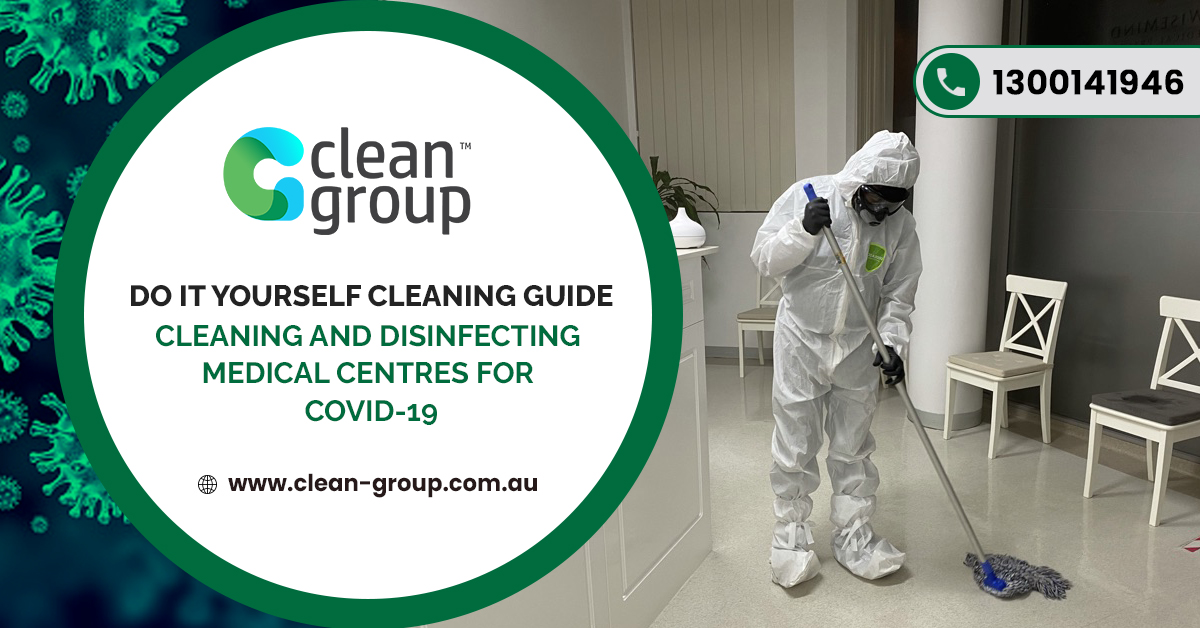COVID-19 has had much of the world in its grips for the last two years, and many still find themselves in quarantine even now. Staff in medical centres know better than anyone how imperative the cleaning and disinfection process is to aid in the fight against the spread of disease.
DIY cleaning in medical centres involves more care and attention than most other commercial spaces, and it also involves more intense chemicals. This guide to cleaning a medical centre during COVID-19 covers all the steps to take, equipment to use, and precautions to take. For more information, Here is a guide to DIY Covid-19 deep cleaning services for medical centres during COVID-19.
Why Is It Essential to Properly Clean and Disinfect Medical Centres During COVID-19?
It has always been absolutely mandatory to keep medical centres clean and hygienic at all times. However, due to the highly infectious nature of the Coronavirus, extreme diligence is more important than ever before.
People go to medical centres for care and assistance. They are often unwell or in an at-risk category, a.k.a. more susceptible to infection and more likely to react badly. If people cannot go to a medical centre without catching a virus, there is very little hope of ever returning to normality.
Health care professionals and medical centre staff have a duty of care to everyone who comes in to provide them with a safe and clean environment. Taking charge of DIY cleaning routines is an excellent way to ensure that happens consistently.
What Is the Difference Between Cleaning and Disinfecting?
The cleaning process is about removing dirt and grime from a surface, clearing germs, and giving something a fresh appearance. Hot water and a detergent solution such as soap, washing liquid, or floor cleaner are required in these kinds of tasks.
Disinfection focuses on killing the bacteria that we cannot see, as it often stays on the surface even after it is clean. To efficiently disinfect a surface, you need to use chemicals that meet the government standards for medical cleaning.
The Essential Steps to Diy Medical Centre Covid-19 Cleaning and Disinfecting
Step One: Clean All Surfaces with Hot Water and Detergent
Always clean before you try to disinfect. Anti-bacterial solutions are more effective on surfaces free of dirt and grime. Hot water with a government-approved cleaning solution is all you need, even in a Medical Centre.
Be careful not to leave floors wet. Patients may slip and fall, which can be dangerous. Using a microfiber disposable mop pad is a hygienic and safe way to efficiently clean floors without leaving a lot of excess water.
Step Two: Pay Extra Attention to Communal-Use Objects
Once the main surfaces are clean, wipe down all the phones, clipboards, handles, railings, and anything else people touch throughout the day.
Step Three: Disinfect General Areas
Using a mid-strength solution (approved for medical use), go back over every surface and item to kill bacteria and limit the chances of the virus lingering. The list includes chairs, tables, doors, and just about anything that you come across.
Step Four: Tackle the Most Sensitive Areas
Medical centres have to pay extra attention in some areas, and they often require a more robust disinfectant. If you have an area that needs to be as sterilised as possible, use a suitable solution.
It is best to carry out the more rigorous tasks after the normal routine to avoid bringing dirt and bacteria in from other areas that have not yet been disinfected.
Step Five: Sterilise Tools
Sterilising is different from disinfecting and a must-do task for medical centre staff with or without COVID-19 present.
Step Six: Refill Sanitizers and Disposable Items
Never let a hand sanitiser bottle run empty and give people an opportunity to go without. Regularly check the levels and pre-empt a situation by refilling it before it finishes. The same applies to paper towels, hand soap, or masks if you provide them for patients.
How Often Should a Medical Centre Be Cleaned During Covid-19?
Medical centres must be deep cleaned every day, with some facilities requiring extra cleaning throughout the working hours. Places, where patients sit or lie down, must be disinfected between uses, as should all medical equipment.
The staff area should be cleaned after every shift, and any shared workspaces need to disinfect every time a new person comes to use them.
One of the most efficient systems to ensure this happens is to employ a policy where each staff member is responsible for wiping down and disinfecting their area before and after every shift. That way, nothing is missed.
A normal daily cleaning routine is a great base to work from, but it is really the bare minimum in a medical centre. Ideally, no patients should be coming into close contact with any items or surfaces that have not been at least cleaned with a disinfectant wipe every hour.
If a medical centre works in multiple staff shifts, all communal areas should be fully sanitised and disinfected before each new rotation.
Cleaning Equipment: What to Use and What to Avoid
Medical centres often have some pieces of specialist cleaning equipment, but you can DIY clean and disinfect most things using basic items. One thing that is of extra importance in medical centres is the cleanliness and hygiene of the cleaning tools themselves.
In areas that require the highest level of disinfection, it is worth using disposable cloths and wipes to keep the standards as high as possible. Other less sensitive areas may only require that all cloths, sponges, and towels are soaked in fresh disinfectant and boiled clean after each use.
There are, however, some things you should not use:
- Anything that may disperse the virus: Pressured water or air, including canned aerosols and disinfectants, actually do more to blow the virus around than to kill it. When infectious particles are airborne, they create a higher risk of contamination. Cleaning equipment that uses force to clean is not suitable for COVID-19 cleaning.
- Dry clothes and dusters: Wiping surfaces with a dry cloth or a duster only moves particles around. This is likely to disturb and disperse the virus and make it more difficult to contain. Only use a dry cloth to wipe down a surface after it has been thoroughly disinfected and cleaned.
- Disinfectant fogging: Contrary to popular belief, this is not an effective solution for COVID-19. It is essentially fumigation, but it does not target germs that may be clinging to a surface. Fogging is also potentially harmful to sick patients because of the high level of chemicals involved in the process.
The best solution is the most simple one- warm water, a damp cloth, and a strong disinfecting detergent solution.
DIY Disinfecting Solution
Ideally, medical centres should always have sufficient supplies of a government-approved disinfectant chemical solution to avoid running out.
If for whatever reason, there is a shortage and no way to get more on time to maintain the necessary standards, it is possible to make an effective mixture using simple materials.
The best DIY disinfecting solution is bleach and water. Natural chemical-free ingredients such as vinegar and baking soda that often appear in-home cleaning remedies are not suitable for COVID-19 cleaning in any facility. They are not effective against infectious bacteria.
Medical centres require different levels of disinfection in different areas. As such, the dilution level of bleach depends on where you are cleaning.
High-Level Disinfection
Areas that require the highest level of disinfection include patient beds, examination and treatment rooms, patient toilets, areas where a positive patient has been, and laboratories.
Basically, any environment where potentially sick people are vulnerable or test samples are handled must be treated with the utmost care.
In these areas, a dilution of one part bleach in 10 parts water is necessary. This type of solution is not necessary for general use and must be handled with gloves, a surgical mask, and eye protection.
Mid-Level Disinfection
Most non-treatment areas in a medical centre require a middle ground disinfectant. Waiting rooms, general use toilets, staff areas, service desks, and most equipment all fall under this section.
Dilute one part of bleach in 50 parts of water and continue to use protective gloves, mask, and eye gear.
Low-Level Disinfection
Generally speaking, every part of a medical centre requires at least a mid-strength disinfectant. However, it is always good to have a gentler solution for more regular use throughout the day that is less likely to irritate skin and eyes.
In this case, mix the bleach 1:80 with water.
What Extra Precautions Should Staff Take?
- Hand sanitisers and disinfectant wipes should be readily available for staff and customer use. At all touchpoints, patients and employees should be encouraged to use them. Some medical centres have even made it mandatory.
- Cross-contamination between staff should be kept to a minimum. The help desk receptionists should sit far apart and protective screens should be used for areas that patients approach.
- Protective items such as masks and gloves are extremely important in medical centres and must be worn by staff and patients at all times.
- Staff should limit unnecessary contact with surfaces. Make it a policy not to touch anything without cause.
Final Thoughts
Medical centres must be kept as sterile as possible at all times, especially during COVID-19 times. The people who require medical centres are often amongst the most at risk and need to rely on the safety of the facilities they use.
Implementing a meticulous DIY cleaning routine amongst the staff is an intelligent step towards controlling the spread of all infectious diseases, Corona or otherwise. Following a few basic rules and regular task rotas is the responsible thing to do.

